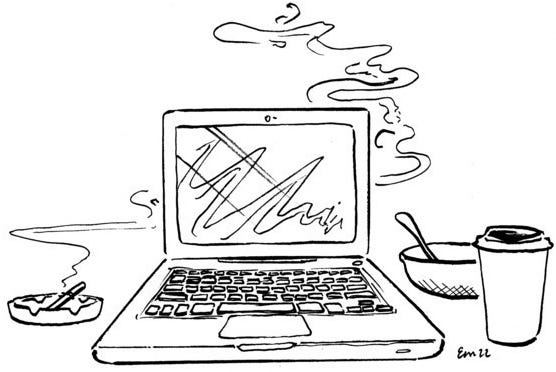This piece is based on a chapter of a book I wrote called David’s Inferno that was published more than a decade ago. In addition to personal stories, it includes information about the science of mental health, prescription drugs, alternative medicine, and therapies; as well as reflections on depression’s impact on relationships, spirituality, and creativity—which is the subject of this essay.
Among the many tropes about the writing life is that it involves long periods of staring at a screen or blank piece of paper, waiting for inspiration.
This sounds admirable, heroic even, and I’m sure that many writers do sit and stare until the words begin to trickle out, then perhaps stream, and then, if they’re lucky, turn into a torrent for at least a few minutes before settling into a steady flow for as long as they can keep it up. Others, of whom I consider myself a poster boy, experience various creative ups and downs during the day, hour, or minute.
Sometimes it seems I spend as much time fine-tuning my neurotransmitters as my words.
If you’ve seen one neurotransmitter, you definitely haven’t seen them all. Depending on who’s counting, there are several dozen different kinds, and each one is a slightly different size and shape. However, in terms of maintaining some kind of enthusiasm for creative work, there are only a few that you need to worry about. Actually, better not to worry at all. Although, if your neurotransmitters are a little off-kilter, you might not have much choice.
Every moment, 86 billion, give or take, neurons (brain cells), with hundreds of nerve endings are sending and receiving “messenger molecules” (neurotransmitters) to and from other neurons by bravely leaping across “huge” gaps (.02 microns or so wide) called synapses.
Figuring out which neurotransmitter is in charge at any moment is a thought exercise at best and a recipe for calculus flashbacks at worst. Besides there’s always more than one getting in on the action.
Still, dopamine is my favorite. It raises alertness and confidence; lowers aggression, compulsivity, and paranoia; makes you more open to new thoughts and experiences; and increases psychological plasticity—a phrase that, by itself, gives me a creative frisson.
Of course, since all your neurotransmitters have to work together, it’s probably not a good idea to play favorites. You wouldn’t want your norepinephrine molecules taking off in a huff, leaving you with high anxiety and a splitting headache; or your serotonin system having its feelings hurt and making your feelings hurt even worse in revenge.
But if I were abandoned on a desert island and could have only one neurotransmitter, it would be dopamine. Because, as I read in one article, “It is hardly a stretch to say that dopamine is the mother of invention.”1
Some of the substances that can convince your neurons to produce more dopamine and launch them into those millions of synaptic divides are sugar, caffeine, nicotine, and alcohol. Sound familiar?
Considering that Coke, Mountain Dew, and the sweet, milky Swee-Touch-Nee tea—that my aunt used to give me when I was young and impressionable—all of which have plenty of sugar and caffeine, I unwittingly succumbed to a fairly well-developed dopamine dependence by the time I was in elementary school. To paraphrase Bob Dylan: I started off on Coca-Cola, but soon hit the harder stuff.
For a while, high school sports satisfied my increasing daily dopamine requirements. But, by the time I was in college, I had added alcohol, cigarettes, and various illegal drugs to the mix. Thankfully, for the last few decades, a combination of medication, meditation, and exercise have provided me with a dopamine baseline, supplemented by regular doses of sugar, caffeine, and alcohol to manage (and undoubtedly trigger) everyday mood swings. When all else fails, there’s always Adderall. I’m certainly not recommending this complex, and not traditionally holistic, prescription. And, I assume, neither would your doctor.
One reason that I wouldn’t want to be responsible for recommending it is that, while dopamine may be the mother of creativity, it can also be the mother (or father) of addiction. When you “use up” a lot of dopamine at once, it creates a craving for more. That’s one reason it’s hard to give up smoking—or, more likely these days—looking at your iPhone screen.
I recently found a website with pictures of 100 writers in their workspaces.2 I expected to see desktops strewn with cigarette burns, wine stains, coffee cups, and bowls of candy. Instead, many are surrounded only by notepads and books. Some are painfully abstemious: Agatha Christie with nothing but a pad next to a typewriter; E.B. White sitting monk-like on a hard bench, typing at a bare table in what looks like an attic room; and, Anne Frank, hauntingly, looking directly at the camera, writing by hand at her simple school desk.
On the other end of the spectrum, Carl Sandburg has a cigar in his mouth; George Orwell has a cigarette in his; as does Jack Kerouac, whose worktable also features several predictable bottles of liquor. J.D. Salinger sits on a suitcase, buck naked, typing on a portable manual typewriter, smoking a pipe. (I didn’t predict that.)
A friend asked me recently if they could watch me write…study my “process.” I found myself at a rare, albeit brief, loss for words. I flippantly suggested she start by getting a pound of coffee, a bottle of wine, and a road bike.
Because while, as these “Asides” illustrate, a lot goes into being a writer, writing is, at times, a relatively small part of it.
The rest is discovering how to get there…and stay there.
De Gustibus.
https://www.scientificamerican.com/article/how-to-cultivate-your-creativity-book-excerpt/
https://writingcooperative.com/100-famous-authors-and-their-writing-spaces-8ee25c50c927




